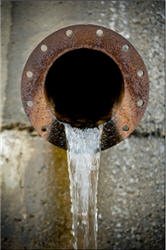
Innovation Leaking Through the Cracks
- By Christina Miralla
- Aug 03, 2011
Water is vital for human existence. Across the globe, 700 million people in 43 countries suffer from water scarcity, according to the United Nations. Here in the United States, with the population doubling over the past 50 years, the U.S. Environmental Protection Agency states by 2013 at least 36 states could experience water shortages, making water conservation crucial.
Because of these staggering statistics, The Dow Chemical Company hosted the Future of Water Conference providing a platform for utility leaders and water conservation groups to present new ideas in an effort to reduce the Earth’s water footprint.
“We have to create a norm behavior that water is now more precious than oil and its users now have an obligation of stewardship,” said Jonathan Lash, president of the World Resources Institute during the virtual conference.
An area of water consumption garnering attention by the EPA is infrastructure sustainability.The EPA recognizes the importance of responsibly managing water resources, which is why it is integrating water management best practices at its facilities.
The same water main pipes that were built decades and even centuries ago are beginning to leak causing significant water loss. In a 2009 report by the American Society of Civil Engineers (ASCE), U.S.
water infrastructure received a D minus score in its Report Card of
America’s Infrastructure. The ASCE report estimated that seven billion
gallons of water is lost due to leaking pipes. According to the EPA, much of our infrastructure is now 100 years old or older, which is why the Clean Water and Drinking Water Infrastructure Sustainability Policy relies on a three-tier plan toward water sustainability – sustainable water infrastructure, sustainable water sector systems and sustainability communities. Developing sustainable infrastructure is vital to the preservation of overall water supply.
Utilities are experiencing excess water waste through leaks because of infrastructure inefficiencies. Until infrastructure funding can support innovative piping development for more than 50,000 water utilities (in the U.S. alone), utilities need to leverage water shortage.
Israeli-based TaKaDu, a software-as-a-service company, created a web-based water infrastructure monitoring system based on real-time analysis of existing data from water network sensors and meters.
The software solutions aim to help utilities reduce water loss and increase efficiency by detecting and alerting utilities upon network problems and inefficiencies while sustainably managing the network.
“There’s no easy way to reduce the cost of maintenance unless you advance technology because the way water networks are maintained – people dig to find problems, people dig in order to replace the pipes, they dig whenever they want to increase the network capacity,” said Guy Horowitz, vice president of marketing at TaKaDu. “It’s all about digging.”
According to Horowitz, a small pipe leak will dispense 1 liter of water per second. Horowitz added, 1 liter per second equals about 0.1 mega liter per day and that mega liter equals about 36 mega liters or 9.5 million gallons lost per year through this small leak.
The monitoring system works by analyzing data from utilities existing distribution meters and sensors, using sophisticated algorithms and statistical models to spot anomalies.
“The more water you lose the less capital and the less time you have left for improving your network, which means water prices must go up in order to allow you to maintain your level of investment capped by the government or the public not willing to pay more,” Horowitz said. “Utilities are trapped in this vicious cycle and there’s no good way out.”
According to Horowitz, the data is being pushed over to TaKaDu servers in the cloud and computers analyze the data quickly and efficiently using smart algorithms and if there’s a problem in the network – a leak, a burst, or any other type of inefficiency – an alert is being generated and pushed directly to the relevant stakeholder in the utility or action could be taken automatically if that’s feasible. The software can save time, money and the risk of human error, by finding the location of a leak. However, the software cannot track the exact spot, but it can reduce the radius and shorten the cycle for typical detection and repair.
In a case study done with Thames Water, a private water and wastewater service company in the United Kingdom, TaKaDu’s water infrastructure monitoring revealed impressive results. Over a six-month trial, covering 3,000 kilometers of water mains, Thames Water detected leak on average nine days earlier compared to previous leak detection methods with 3.5 hours of prior burst warning. Leak detection crew efficiency increased by 2.5 times because of the TaKaDu’s advanced geographic targeting and localization alerts. Overall, Thames Water saw a 250 percent return on investment in monitored areas.
“Now, that’s an example for innovation and the way innovation can solve this water scarcity problem,” Horowitz said.
About the Author
Christina Miralla is the associate content editor for 1105 Media, Inc. She can be reached at cmiralla@1105media.com.